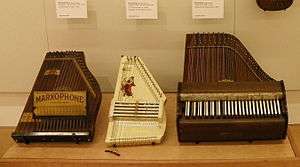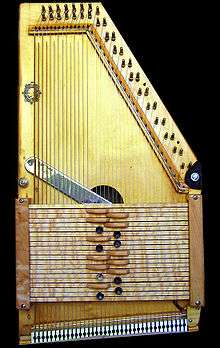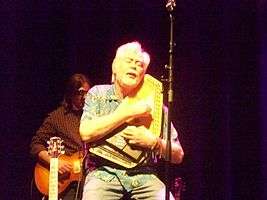Autoharp

The autoharp is a trademark for a string instrument having a series of chord bars attached to dampers, which, when depressed, mute all of the strings other than those that form the desired chord. Despite its name, the autoharp is not a harp at all, but a chorded zither.[1][2]
History

Debate exists over the origin of the autoharp. A German immigrant in Philadelphia, Charles F. Zimmermann, was awarded US 257808 in 1882 for a design for a musical instrument that included mechanisms for muting certain strings during play. He named his invention the "autoharp".[3] Unlike later autoharps, the shape of the instrument was symmetrical, and the felt-bearing bars moved horizontally against the strings instead of vertically. It is not known if Zimmermann ever commercially produced any instruments of this early design. Karl August Gütter of Markneukirchen, Germany, built a model that he called a Volkszither, which most resembles the autoharp played today. Gütter obtained a British patent for his instrument circa 1883–1884. Zimmermann, after returning from a visit to Germany, began production of the Gütter design in 1885, but with his own design patent number and catchy name. Gütter's instrument design became very popular, and Zimmermann has often been mistaken as the inventor.
Trademark
A stylized form of the term Autoharp was registered as a trademark in 1926.[4] The word is currently claimed as a trademark by U.S. Music Corporation, whose Oscar Schmidt division manufactures Autoharps. The USPTO registration, however, covers only a "Mark Drawing Code (5) WORDS, LETTERS, AND/OR NUMBERS IN STYLIZED FORM" and has expired.[5] In litigation with George Orthey, it was held that Oscar Schmidt could only claim ownership of the stylized lettering of the word Autoharp, the term itself having moved into general usage.
Construction
Modern autoharps have 36 or 37 strings, although some examples with as many as 47 strings, and even a rare 48-string model exist. They are strung in either diatonic (one, two, or three key models) or chromatic scales. Standard models have 15 or 21 chord bars, or buttons, available, a selection of major, minor, and dominant seventh chords. These are arranged for historical or systemic reasons, as for example:[6] A variety of Chord Bar Layouts may be found in an article of the same name seen here: http://daigleharp.com/howtocorner.html
| E♭ | B♭ | F | C | G | D | A | ||||||||||||||
| F7 | C7 | G7 | D7 | A7 | E7 | B7 | ||||||||||||||
| A♭ | B♭7 | Cm | Gm | Dm | Am | Em |
Although the autoharp is often thought of as a rhythm instrument for playing chordal accompaniment, modern players can play melodies on the instrument. Diatonic players are able to play fiddle tunes using open-chording techniques, "pumping" the damper buttons while picking individual strings. Skilled chromatic players can perform a range of melodies.
Diatonically strung single-key instruments from modern luthiers, such as Orthey, Fladmark, Hollandsworth, D'Aigle, Baker, Daniels, and Goose Acres, are known for their lush sound. This is accomplished by doubling the strings for individual notes. Since the strings for notes not in the diatonic scale need not appear in the string bed, the resulting extra space is used for the doubled strings, resulting in fewer damped strings. Two- and three-key diatonics compromise the number of doubled strings to gain the ability to play in two or three keys, and to permit tunes containing accidentals, which could not otherwise be rendered on a single key harp. A three-key harp in the circle of fifths, such as a GDA, is often called a festival or campfire harp, as the instrument can easily accompany fiddles around a campfire at a festival in their favored keys.

Electric autoharp
Until the 1960s, no pickups were available to amplify the autoharp other than a rudimentary contact microphone, which had a poor-quality, tinny sound. Eventually, a bar magnetic pickup was designed by Harry DeArmond, and manufactured by Rowe Industries. Pinkerton's Assorted Colours used the instrument on their 1966 single "Mirror, mirror".[7] In the 1970s, Oscar Schmidt came out with their own magnetic pickup.
Shown at the right is a 1930 refinished Oscar Schmidt Inc. Model "A". This harp has two DeArmond magnetic pickups (one under the chord bars), with a d'Aigle fine-tuning mechanism, and d'Aigle chord bar assembly, and was used in a 1968 MGM Records/Heritage Records recording by Euphoria.
A synthesized version of the autoharp, the Omnichord, was introduced in 1981 and is now known as the Q-Chord, described as a "digital songcard guitar".
Notable performers

Autoharps have been used in the United States as bluegrass and folk instruments, perhaps most famously by Maybelle Carter, Sara Carter, Helen Carter and June Carter, all of the Carter Family. They are relatively easy to learn to play as a rhythm instrument, but offer great rewards to the more committed player as a melody instrument. Grand Ole Opry star Cecil Null was the first to develop the upright style for playing the autoharp that was in turn used by the Carter Family.
Maybelle Carter's granddaughter Carlene Carter frequently plays the autoharp onstage and on her recordings; her song "Me and the Wildwood Rose", a tribute to her grandmother, makes prominent use of the autoharp.
Norwegian Avant-Garde Artist Sturle Dagsland frequently performs with an Autoharp. [8]
Several Lovin' Spoonful songs feature the autoharp playing of John Sebastian, including "Do You Believe in Magic" and "You Didn't Have to Be So Nice". He also played in the 1979 Randy VanWarmer hit song "Just When I Needed You Most".[9]
Janis Joplin also played the autoharp, which can be heard in her early, unreleased recording "So Sad to Be Alone".[10]
British singer songwriter Corinne Bailey Rae regularly plays the autoharp and composed the title track "The Sea" from her 2010 Mercury Award nominated album called The Sea using chords that she composed on the autoharp.[11]
See also
- Aeolian harp
- Dolceola
- Guitar zither (chord zither, fretless zither)
- Guitaro
- Marxophone
- Omnichord (electronic autoharp)
- Zither
References
- ↑ Kelly Williams (May 11, 2003). "Background of the Guitar-Zither". The Guitar-Zither Clearinghouse.
terminology on the "Chorded zither" (referred Autoharp without trademark infringement with Oscar Schmidt International), "Guitar-Zither" (patented by Fred Menzenhauer in 1894), and "Chord zither" (referred Guitar-Zither, appeared in The Oxford Companion to Musical Instruments, and The New Grove Dictionary of Musical Instruments). - ↑ Gregg Miner and Kelly Williams (July 2011). "Selecting the Term". Fretless Zithers.
terminology and taxonomy of the "Fretless Zither" family instruments. - ↑ The True History of the Autoharp
- ↑ U.S. Patent and Trademark Office, Trademark Electronic Search System, September 7, 2006.
- ↑ U.S. Patent and Trademark Office, Trademark Electronic Search System, May 25, 2009.
- ↑ Orthey, Mary Lou (2001). Autoharp Owner's Manual, p.3. ISBN 0-7866-5883-5.
- ↑
- ↑ "Indie electro, cybercore ja psühhedeelne vibe @ TMW" (in Estonian). www.postimees.ee. Retrieved 2016-09-01.
- ↑ Hyatt, Wesley (1999). The Billboard Book of #1 Adult Contemporary Hits (Billboard Publications), pages 228-9.
- ↑ "So Sad to Be Alone" audio recording
- ↑ Interview with Corrine Bailey Rae on BBC Six Music about her Mercury nominated album "The Sea", Wednesday, 1 September 2010.
External links
- Autoharp Quarterly
- A Brief History of 19th Century Autoharp Manufacturers
- The Autoharp Page
- Kami Maltz plays the Autoharp